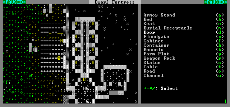The picture has to be a mistake, right? It looks like someone vomited up a spreadsheet, because that’s way too complicated and meaningless to be any sort of game, right?
As it turns out, not only is this a game, but it’s one of the most realistic, in-depth, and fulfilling games I’ve ever played.
But how can that be, I hear you ask (I have excellent hearing). It’s two dimensional. All the game’s art consists of ASCII characters. How can THIS be a realistic game?
While it’s true that the graphics in Dwarf Fortress are several leaps and bounds behind modern-day gaming, the gameplay more than makes up for it. If there’s an objective you want to set for yourself, you can probably accomplish it, no matter what it is.
Gameplay is split into two modes – Adventure mode, where the player takes control of a single Dwarven adventurer, and the wildly popular Fortress mode, where the player takes the position of someone building an entire Dwarven metropolis out of seven founders, some food, and a mining pick.
In adventure mode, your adventurer wanders around fighting monsters and seeking out treasure, either for your personal advancement or in the service of the leaders of various towns. The mode is very straightforward, but it has its specific appeals, such as being able to explore fortresses that you’ve built yourself, assuming you can find them in the absolutely enormous worlds.
Oh yes, the worlds. The game uses its own system of generating a new, dynamic world with a unique and rich history every single time you play. How well does it work? Well, so far, outside of sharing world files, no two Dwarf Fortress players have ever generated the same world in the years it’s been since the game’s release. Even the histories are different every time, with major events, heroes, and even civilizations reacting dynamically to the changes in the world they’re placed in. So no matter how many times you play, you’ll never, ever, ever have the same experience.
This makes itself more evident in Fortress mode, where you pick a little chunk of this massive world to embark on, and take seven Dwarves and some supplies with you. Your objective? Turn this tiny outpost into a massive Dwarven city, bursting at the seams with riches and marvels of engineering. How do you approach this objective? However you want.
Maybe your first step is to dig as deep into the earth as you can, positioning yourself against natural boundaries like a cliff or river to isolate yourself from dangers. Maybe you focus on creating a strong military to protect yourself against the ever-present threat of goblin ambushes and sieges. Maybe you have your dwarves shore up your defenses, constructing moats, drawbridges and guard outposts to make your fortress impregnable to outside influence.
However you want to approach it, the game will probably let you do it. What’s the catch? Well, for one, the learning curve. The problem with having such a complex game is that it’s going to be difficult to learn how to play, and even the veteran players are still experimenting and discovering new things. For example, my first several fortresses failed because I couldn’t figure out how to build a farm so my poor founding dwarves wouldn’t starve to death. Then once I was able to ward off starvation, I had to create homes for them, and the side of my mountain looked like whoever had been digging the place out was blind, because I hadn’t thought in advance about the layout of the place, and I was just sort of digging things out as I needed them without thought to the fact that I’d eventually have to expand. Then I had to wrap my head around the concept of the multiple levels along the z-axis, which basically represent different heights like they would multiple stories in a building. Then goblins ambushed me, and without having considered making a military to defend myself my fortress quickly crumbled to the last.
Don’t let that dissuade you, though. It is a challenge to get the hang of this game, I’ll admit, and the sometimes-chaotic ASCII art doesn’t help the matter. But once I finally started to learn what was what – for example, that my dwarves slowed down considerably and became unhappy without an ample supply of booze, of which they consume roughly three full barrels on a slow day, or that I couldn’t train more dwarves out of nowhere like in other RTS games, I had to wait for people to immigrate to my fortress and then assign them jobs – the game quickly got a thousand times more fun.
I began to set myself up with outrageous goals, and dedicate the resources of my entire fortress to achieve them. Most notably, I had a fortress with a glass drawbridge suspended over a moat filled with magma (suspend disbelief), roads paved over with the finest gold my smelters could refine, and a massive marble tower filled with three squads of archers to watch my entrance for enemies night and day.
The truth is, there’s so much to this game I could go on for hundreds of pages on the things you can do and how they’re accomplished, and I still wouldn’t have covered everything. Yes, the graphics are primitive, and yes, the interface is hard to grasp. But once you get into the groove of things, you’ll find yourself planning out marvels of Dwarven engineering in no time.
Dwarf Fortress is made for Windows and Mac by an independent publisher, Bay 12 Games (www.bay12games.com). So unless you’re running Linux or some other home-brewed operating system, there’s no excuse not to pick up a copy – especially since it all comes at the low low cost of free.
Just remember – don’t screw with water, and losing is fun.










